Migrant integration statistics - housing
Data extracted in October 2023.
Planned article update: September 2024.
Highlights
Among people aged 18 years or over living in the EU, 23.3 % of non-EU citizens and 35.3 % of EU citizens living in another EU country lived in owner-occupied dwellings in 2022. The share was more than double for EU nationals living in their own country (73.7 %).
Among people aged 18 years or over living in the EU, 32.9 % of non-EU citizens residing in the EU lived in overcrowded housing in 2022; for EU citizens of other EU Member States the share was 20.5 % while for EU nationals living in their own country it was 13.9 %.
Among people aged 18 years or over living in the EU, 8.7 % of EU nationals living in their own country experienced high housing costs in 2022. This share was twice as high (17.0 %) among citizens of other EU Member States and higher still (22.1 %) among non-EU citizens.
Housing cost overburden rate of persons aged 18 years or over, by citizenship, EU, 2013–2022
Housing is considered an important element for the well-being of individuals. Indeed, the quality and affordability of housing is often seen as crucial for measuring living standards and social inclusion/exclusion. This article presents European statistics for three main housing indicators: home ownership, overcrowding and housing cost overburden rates. These rates are analysed according to an individual’s citizenship or country of birth. Information is presented for various groups of foreign citizens or foreign-born persons and compares these with EU nationals living in their own country or native-born persons living in their own country. Foreign citizens include EU citizens living in another EU Member State than their country of citizenship and non-EU citizens. Similarly, foreign-born persons include EU-born persons living in another EU Member State than their country of birth and non-EU-born persons.
This article forms part of an online publication on migrant integration statistics.
Full article
Overview
The data presented in this article are from the EU statistics on income and living conditions (EU-SILC). The information presented generally refers to people aged 18 years or over. For some analyses, two age groups are presented: people aged 18–54 years and people aged 55 years or over.
Three main housing indicators are presented in this article. This overview focuses on an analysis of these three indicators by citizenship. The following three sections – one for each indicator – present information not only by citizenship but also by country of birth.
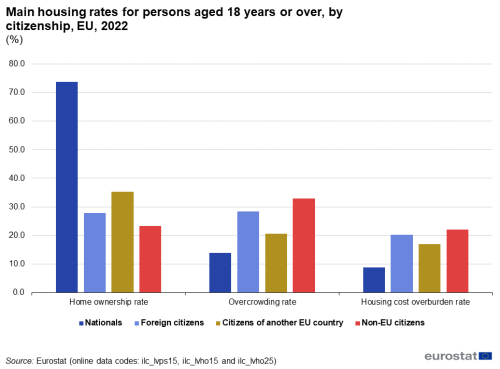
(%)
Source: Eurostat (ilc_lvps15), (ilc_lvho15) and (ilc_lvho25)
In the EU, 73.7 % of EU nationals living in their own country lived in owner-occupied dwellings in 2022. This was more than double the share for EU citizens living in another EU Member State (35.3 %) and more than three times the share for non-EU citizens residing in the EU (23.3 %) – see Figures 1 and 2.
Among people living in the EU, 13.9 % of EU nationals living in their own country lived in overcrowded housing in 2022. For EU citizens living in another EU country, the share was 20.5 %, 1.5 times the share for EU nationals living in their own country. For non-EU citizens residing in the EU, the share was 32.9 %, more than twice the share for EU nationals living in their own country.
In the EU, 8.7 % of EU nationals living in their own country faced total housing costs in 2022 that were in excess of 40 % of their disposable income. This share was two times as high (17.0 %) among EU citizens living in another EU Member State; it was higher still (22.1 %) among non-EU citizens residing in the EU, 2.5 times as high as the share for EU nationals living in their own country.
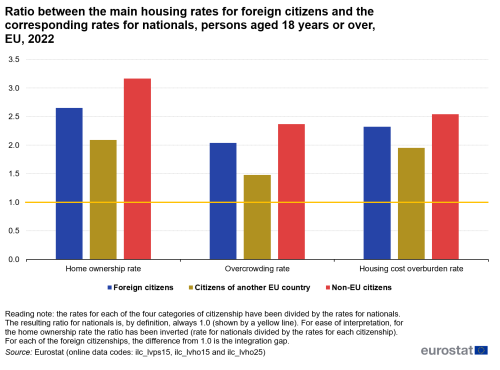
Source: Eurostat (ilc_lvps15), (ilc_lvho15) and (ilc_lvho25)
Housing tenure: home ownership rate
The home ownership rate is the percentage of people who lived in an owner-occupied dwelling. Home owners may or may not have an outstanding mortgage or housing loan. People who do not live in an owner-occupied dwelling live in rented accommodation, in dwellings with a market rent or in a reduced-rent or rent-free dwelling.
Between 2013 and 2019, the home ownership rate for EU nationals living in their own country remained relatively stable in the EU, between 72.7 % and 73.1 %. In 2020 and 2021, this rate increased to 74.1 % and 74.2 % respectively before landing at 73.7 % in 2022. Over this period (2013 to 2022), the home ownership rates for foreign citizens living in the EU Member States declined.
- For EU citizens living in another EU Member State, the fall was 6.0 percentage points, from 41.3 % to 35.3 %.
- For non-EU citizens residing in the EU the fall was slightly greater, down 8.0 percentage points from 31.3 % to 23.3 %.
When analysed by country of birth, similar developments were observed in the EU: a relatively stable home ownership rate between 2013 and 2019 for native-born persons, with growth in 2020; falling rates between 2013 and 2022 for foreign-born persons.
While the developments in the two parts of Figure 3 are quite similar, there is one notable difference: for all years from 2013 to 2022, the home ownership rates in the EU were higher for foreign-born persons than for foreign citizens living in the EU.
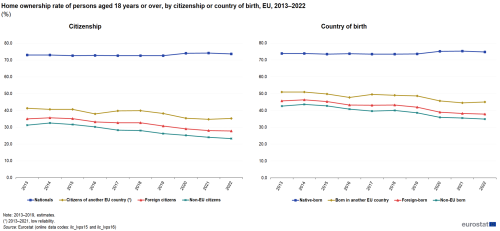
(%)
Source: Eurostat (ilc_lvps15) and (ilc_lvps16)
As would be expected, home ownership rates were higher among people aged 55 years or over than among people aged 18–54 years: this was observed in the EU in 2022 for all categories of citizenship and country of birth – see Figure 4.
- The narrowest differences by age in home ownership rates were for EU nationals living in their own country (8.6 percentage points) and native-born persons living in their own country (8.8 percentage points). Much larger differences were observed for the various categories of foreign citizens and foreign-born persons living in the EU country.
- The widest differences by age in these rates were observed for EU citizens living in another EU Member State than their country of citizenship (18.1 percentage points; low reliability) and for persons born in another EU Member State than their country of residence (18.6 percentage points).
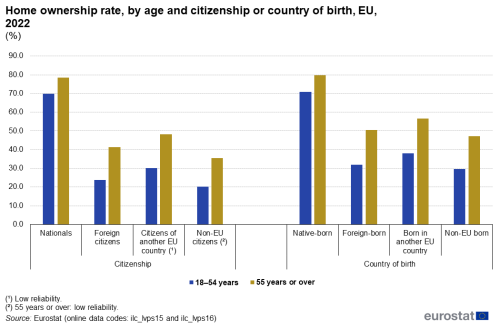
(%)
Source: Eurostat (ilc_lvps15) and (ilc_lvps16)
Among EU Member States, the highest home ownership rate in 2022 for EU nationals living in their own country was in Romania (95.3 %). This rate was also above 90.0 % in Slovakia, Croatia and Hungary. All Member States reported home ownership rates for EU nationals living in their own country above half, with the lowest in Germany (51.0 %); a somewhat lower rate was recorded in Switzerland (49.7 %; 2021 data).
For foreign citizens living in the EU country, there was a much greater range between the EU Member States for home ownership rates in 2022. While a rate of 88.7 % was observed in Croatia, it was below half in most Member States (15 out of 26; no data for Romania), with the lowest rates below one fifth in Austria (19.7 %) and Italy (18.7 %).
In all EU Member States with reliable data (no data for Romania), home ownership rates in 2022 were higher for EU nationals living in their own country than for foreign citizens living in the EU country. The largest differences between these two rates were in Italy (61.8 percentage points), Slovenia (57.4 percentage points), Greece (53.0 percentage points) and Spain (50.2 percentage points). In four EU Member States, the rate for nationals was less than 10.0 percentage points higher than the rate for foreign citizens living in the EU country: Croatia (3.5 percentage points), Latvia, Bulgaria (both 2.3 percentage points) and Estonia (0.2 percentage points). The narrow differences between the rates for nationals and foreign citizens living in the EU country observed in Latvia and Estonia may in part reflect the inclusion of recognised non-citizens living in the EU country who are permanently resident but have not acquired any other citizenship.
An analysis of home ownership rates in 2022 for the two subpopulations of foreign citizens is available for 22 EU Member States. In 20 of these, the rates for EU citizens living in another EU Member State than their country of citizenship were higher than those for non-EU citizens residing in the EU country. The exceptions to this were Ireland and Estonia, where home ownership rates for non-EU citizens were higher. In Estonia, the home ownership rate for non-EU citizens was even higher than the rate for Estonian nationals.
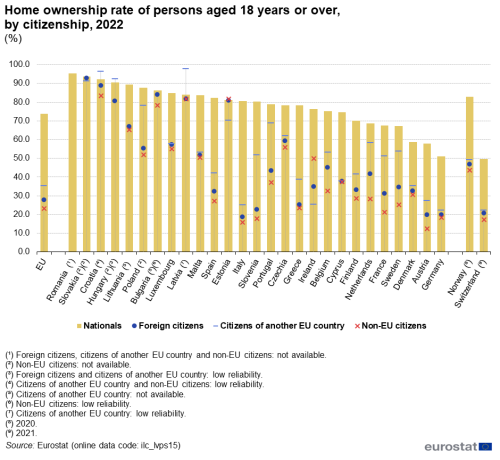
(%)
Source: Eurostat (ilc_lvps15)
Housing conditions: overcrowding rate
The overcrowding rate is defined as the percentage of the population living in an overcrowded household.
Between 2013 and 2022, the overcrowding rate for EU nationals living in their own country fell steadily, down 2.3 percentage points from 16.2 % to 13.9 %. By contrast, the overcrowding rates for foreign citizens increased.
- For EU citizens living in another EU Member State, the increase was 5.8 percentage points, from 14.7 % to 20.5 %. As such the rate for EU citizens living in another EU Member State was below that of nationals living in their own country from 2013 to 2014 and surpassed it in 2015.
- For non-EU citizens residing in the EU the increase was somewhat less, up 1.9 percentage points from 31.0 % to 32.9 %.
Due to these quite different developments between 2013 and 2022 for the overcrowding rates of EU nationals living in their own EU Member States and foreign citizens living in the EU, the gap between the rates widened in the EU. In 2013, the gap was 8.8 percentage points and by 2022 it had reached 14.4 percentage points.
When analysed by country of birth, similar developments were observed in the EU: a relatively steady decrease in the overcrowding rate for native-born persons living in their own country alongside larger increases for foreign-born persons living in the EU Member States. The overcrowding rate for EU-born living in another EU country surpassed that of native-born persons living in their own country in 2019. For all years from 2013 to 2022, overcrowding rates in the EU were higher for foreign citizens than for foreign-born persons living in the EU Member States.
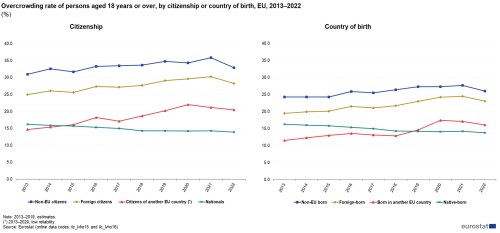
(%)
Source: Eurostat (ilc_lvho15) and (ilc_lvho16)
Overcrowding rates were considerably lower among people aged 55 years or over than among people aged 18–54 years. This pattern was observed in the EU in 2022 for all categories of citizenship and country of birth – see Figure 7. The differences between the rates for the two age groups did not vary greatly by citizenship or country of birth.
- The narrowest differences by age in overcrowding rates were for non-EU citizens residing in the EU (10.2 percentage points).
- Somewhat larger differences were observed for the various categories of foreign-born persons in the EU Member States.
- The widest differences by age in these rates were observed for persons non-EU born residing in the EU countries: the gap was 13.8 percentage points, resulting from an overcrowding rate of 30.2 % for people aged 18–54 years and 16.4 % for people aged 55 years or over.
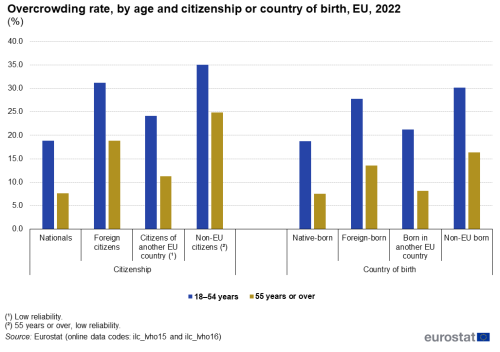
(%)
Source: Eurostat (ilc_lvho15) and (ilc_lvho16)
Among EU Member States, the highest overcrowding rates in 2022 for EU nationals living in their own country were in Latvia (37.5 %) and Romania (35.7 %). This rate was also above 25.0 % in Poland, Bulgaria, Croatia and Slovakia. In 14 Member States, overcrowding rates for EU nationals living in their own country were below 10.0 %. The lowest rate was 1.3 % in Cyprus.
For foreign citizens living in the EU, there was a greater range between the EU Member States for overcrowding rates in 2022. The highest rate, and the only one above 50.0 % was recorded in Poland (50.4 %). By contrast, the rate for foreign citizens was below 10.0 % in four Member States, with the lowest rate in Cyprus, 4.9 %.
In all EU Member States with reliable data except for Bulgaria and Croatia, overcrowding rates in 2022 were lower for EU nationals living in their own country than for foreign citizens living in the EU country. The largest difference between these two rates was in Austria (29.9 percentage points). In four Member States, the rate for EU nationals living in their own country was less than 4.0 percentage points lower than the rate for foreign citizens: Malta, Cyprus (both 3.6 percentage points), Estonia (3.0 percentage points) and Latvia (2.3 percentage points). In Bulgaria and Croatia, overcrowding rates for nationals were 10.3 and 1.1 percentage points, respectively, higher than the rates for foreign citizens.
An analysis of overcrowding rates in 2022 for the two subpopulations of foreign citizens with reliable data is available for 19 EU Member States. In 17 of these, the rates for EU citizens living in another EU Member State were lower than those for non-EU citizens. The exceptions to this pattern were Cyprus and Denmark, where the overcrowding rates of non-EU citizens were lower.
- In Estonia and Slovenia, the overcrowding rate for citizens of other EU Member States was lower than for nationals.
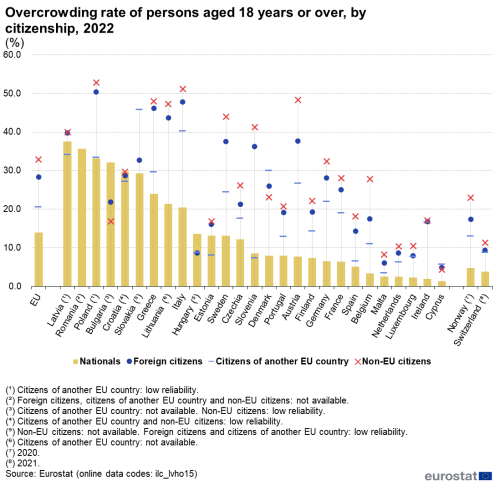
(%)
Source: Eurostat (ilc_lvho15)
The overcrowding rate is linked with other material and social deprivation measures and with income. The scatterplot in Figure 9 shows the overcrowding rate for all foreign citizens living in the EU Member State and compares this with the median equivalised disposable income (hereafter referred to as the median income) for foreign citizens living in the country. In 2022, the EU overcrowding rate was 28.3 % and the median income was €17 430. Among the EU Member States, there was a negative relation between these two indicators: although there were several exceptions, lower rates of overcrowding were generally observed in Member States with higher median incomes and higher overcrowding rates where median incomes were lower.
- Germany, Denmark, Finland, Belgium, Luxembourg, the Netherlands, Ireland and Malta are situated in the upper left quadrant, with overcrowding rates below the EU average and median incomes above the average; Norway (2020 data) and Switzerland (2021 data) are also in this quadrant.
- By contrast, in the diagonally opposite quadrant (bottom right), are Italy, Poland, Greece, Latvia, Lithuania, Croatia and Slovenia, all with above average overcrowding rates and below average median incomes.
- In Sweden and Austria, overcrowding rates and median incomes were both above average.
- In France, Bulgaria, Portugal, Czechia, Spain, Estonia and Cyprus, overcrowding rates and median incomes were both below average.
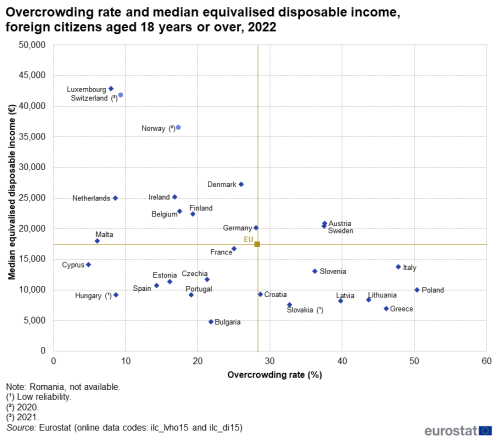
Source: Eurostat (ilc_lvho15) and (ilc_di15)
Housing affordability: housing cost overburden rate
The housing cost overburden rate is the percentage of the population living in households where total housing costs (net of housing allowances) represent more than 40 % of disposable income (net of housing allowances).
In the EU, the housing cost overburden rate for EU nationals living in their own country decreased between 2013 and 2020, falling from 11.0 % to 7.2 % in 2020; the largest decrease (down 1.9 percentage points) was in 2020. In 2021, this development reversed, and the rate increased up to 8.7 % in 2022.
During the period under consideration (2013 to 2022), developments for the housing cost overburden rate of foreign citizens in the EU were more volatile, but broadly similar: an initial increase followed by a clear downward trend with a minor increase in 2021. However, the development in 2021 was clearly different for the two subpopulations of foreign citizens, as the rate increased 2.7 percentage points for non-EU citizens but fell 0.5 percentage points for citizens of other EU Member States. In 2022, the rate decreased again in both subpopulations.
Overall, between 2013 and 2022 the housing cost overburden rate in the EU fell 4.3 percentage points for EU citizens living in another EU Member State, 5.6 percentage points for non-EU citizens residing in the EU and 2.3 percentage points for EU nationals living in their own country.
When analysed by country of birth, similar developments were observed:
- an overall decline in the housing cost overburden rate between 2013 and 2020 followed by an increase in the rate for all of the categories;
- more volatility in the rates for all categories of foreign-born persons living in the EU country than for native-born persons living in their own country.
In all years from 2013 to 2022, housing cost overburden rates in the EU were lower for foreign-born persons than for foreign citizens living in the EU Member State. The gap was larger between non-EU born persons and non-EU citizens residing in the EU than it was between people born in other EU Member States and EU citizens living in another EU Member State.
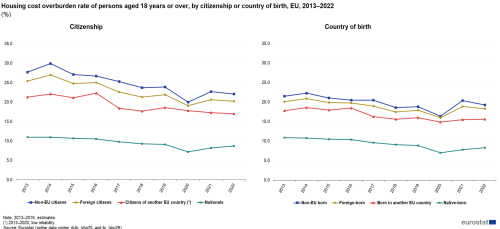
(%)
Source: Eurostat (ilc_lvho25) and (ilc_lvho26)
Housing cost overburden rates were relatively similar for people aged 18–54 years and for people aged 55 years or over. Somewhat lower rates were observed for people aged 18–54 years (than for people aged 55 years or over) in all categories – see Figure 11.
The narrowest difference by age in housing cost overburden rates was for non-EU born residing in the EU (0.4 percentage points), while the widest difference was observed for EU citizens living in another EU Member State (3.3 percentage points; low reliability).
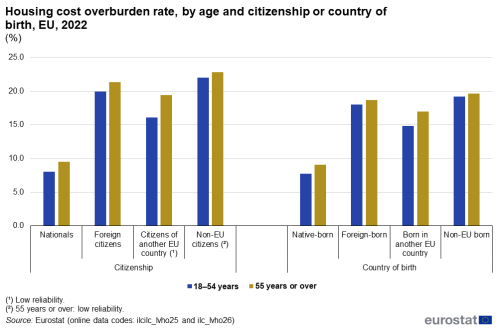
(%)
Source: Eurostat (ilc_lvho25) and (ilc_lvho26)
The highest housing cost overburden rates in 2022 for EU nationals living in their own country were observed in Greece (25.4 %). This rate was also above 10.0 % in Denmark, Bulgaria, Luxembourg and Germany. There were eight Member States that reported housing cost overburden rates for EU nationals living in their own country below 5.0 %, with the lowest in Malta (2.0 %) and Cyprus (1.5 %).
For foreign citizens living in the EU country, there was a much greater range between the EU Member States for housing cost overburden rates in 2022. Greece again reported the highest rate, 39.4 %, followed by Spain (38.4 %). The housing cost overburden rate for foreign citizens was below 10.0 % in five Member States with reliable data, with the lowest rates in Finland (7.0 %), Estonia (6.0 %) and Croatia (4.3 %).
In all EU Member States (no data for Romania), housing cost overburden rates in 2022 were lower for EU nationals living in their own country than for foreign citizens living in the EU country. The largest differences between these two rates were in Spain (32.7 percentage points) and Portugal (27.3 percentage points).
An analysis of housing cost overburden rates in 2022 for the two subpopulations of foreign citizens living in the EU country is available for 19 EU Member States with reliable data. In a majority (13) of these, the rates for EU citizens living in another EU Member State were lower than those for non-EU citizens. The exceptions to this pattern were Czechia, Slovenia, Denmark, Estonia, Finland and Malta, where the housing cost overburden rates for non-EU citizens residing in the EU country were lower. In Finland, the housing cost overburden rate for non-EU citizens residing in Finland was even lower than the respective rate for Finnish nationals.
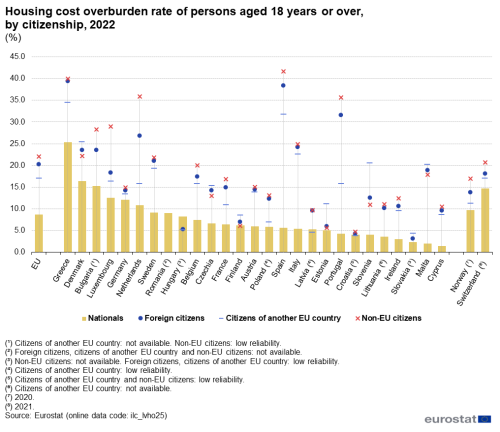
(%)
Source: Eurostat (ilc_lvho25)
Source data for tables and graphs
Data sources
The data presented in this article are from the EU statistics on income and living conditions (EU-SILC). Note that the age coverage used in this article may not be the same as that used by Eurostat in the area of social inclusion statistics and for this reason results may differ slightly from information that is published elsewhere.
The main housing indicators are defined as follows.
- The home ownership rate is the percentage of people who lived in an owner-occupied dwelling, regardless of whether or not there is an outstanding mortgage or housing loan.
- A household is considered overcrowded when it does not have at its disposal a minimum number of rooms, depending on the household’s size, family situation and the ages of its members.
- The housing cost overburden rate shows the share of the population living in households that spend 40 % or more of their disposable income on housing. In general, housing costs include:
- mortgage interest and principal payments (for homeowners) and rental payments (for tenants),
- structural insurance, mandatory services and charges (for example, sewage or waste removal),
- the cost of utilities (such as water, electricity, gas and heating),
- regular maintenance and repairs to the dwelling,
- taxes (if applicable).
Equivalised disposable income is the total income of a household, after tax and other deductions, that is available for spending or saving, divided by the number of household members converted into equalised adults (by weighting each member according to their age).
For more information on the data sources used, please consult EU statistics on income and living conditions (EU-SILC) methodology.
In several EU Member States, the detailed classification of foreign citizens and migrants by country of birth identifies quite small numbers of people. As the data source is a sample survey, the reliability of data in such cases may be low. Data that are of low quality are published with an appropriate footnote while some data cannot be published for reasons of confidentiality.
Context
In November 2020, an Action Plan on Integration and Inclusion 2021–2027 (COM(2016) 377 final) was adopted with the purpose of fostering social cohesion and building inclusive societies for all. Inclusion for all is about ensuring that all policies are accessible to and work for everyone, including migrants and EU citizens with migrant background. This plan includes actions in four sectoral areas (education and training, employment and skills, health and housing) as well as actions supporting effective integration and inclusion in all sectoral areas at the EU, Member State and regional level, with a specific attention paid to young people.
More information on the policies and legislation in force in this area can be found in an introductory article on migrant integration statistics.
Direct access to
Online publications
- Foreign-born people and their descendants
- Living conditions in Europe
- Migrant integration statistics
Methodology
- Social inclusion (mii_soinc)
- Living condition (mii_lc)
- Income and living conditions (ilc) (ESMS metadata file – ilc_esms)
- Income and living conditions – methodology
- Migrant integration statistics – methodology
- Action Plan on Integration and Inclusion 2021–2027
- European Commission – Directorate-General for Migration and Home Affairs (DG HOME), see:
- European Migration Network (EMN)
- European Website on Integration
- OECD – Housing
- OECD – Migration, see:
- United Nations – Demographic and Social Statistics – Housing
- World Health Organization – Housing and health guidelines
- World Health Organization – Housing impacts health